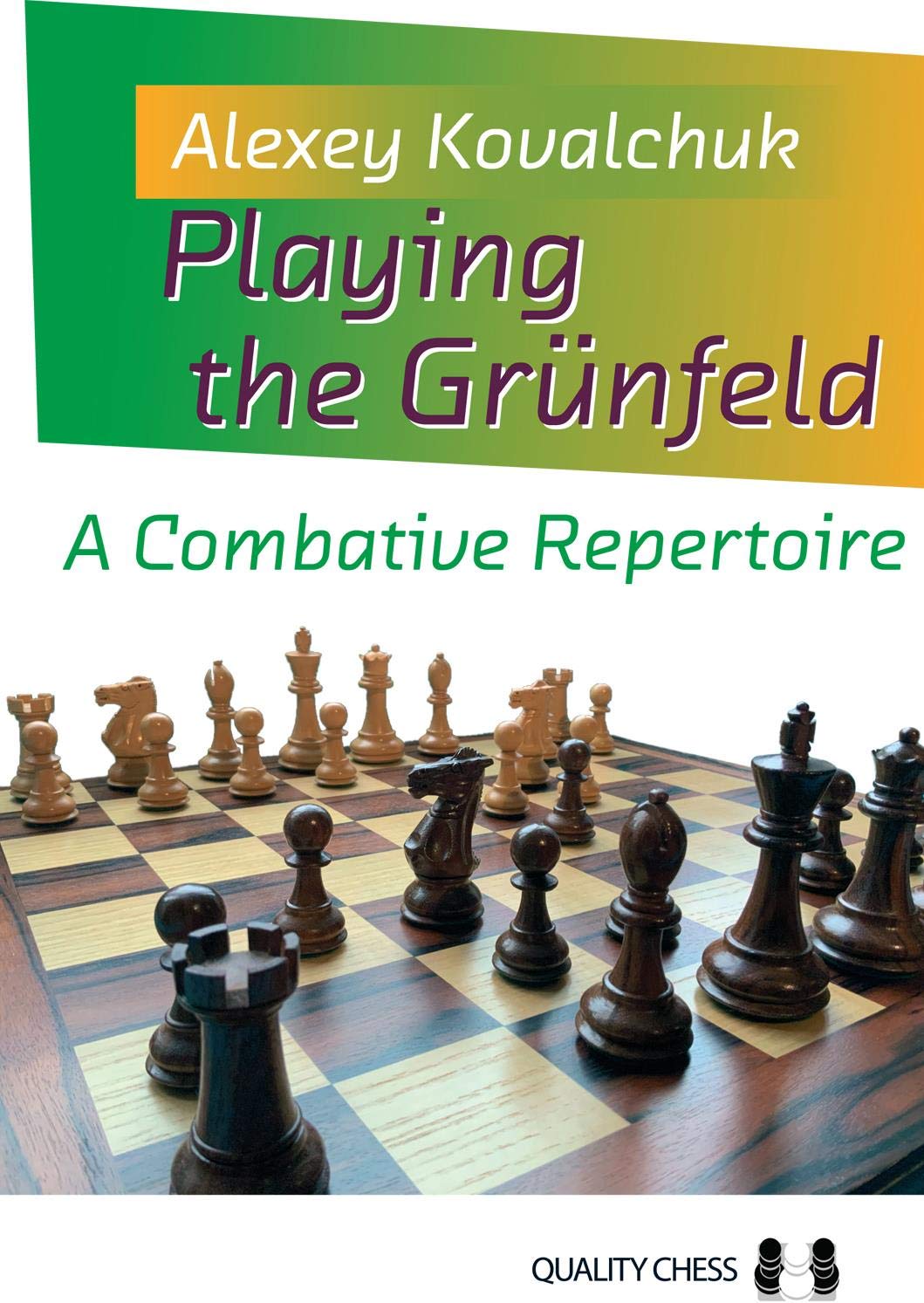
From the rear cover :
“Alexey Kovalchuk is a Russian player whose rating reached 2445 in recent years. In additional to winning the Rostov Championship and numerous other tournaments, he is a theoretician who works as a second for strong chess grandmasters.”
Also from the rear cover
“The Grünfeld Defence is well known to be one of Black’s best and most challenging responses to 1.d4, and has long been a favorite choice of elite players including Kasparov, Svidler, Caruana, Vachier-Lagrave and many more. As with many chess openings, however, it can be difficult to navigate the ever-expanding jungle of games and theory. Playing the Grünfeld offers an ideal solution for practical chess players. Alexey Kovalchuk is a young Russian talent with expert knowledge of the Grünfeld, and in this book he shares his best ideas to form a complete, coherent and combative repertoire for Black. In addition to theoretical soundness, efforts have been made to avoid variations leading to early forced draws, as well as those in which Black allows his king to be attacked at an early stage.”
This book, published by Quality Chess, is a substantive addition to the literature covering the Grünfeld Defence. I write “substantive” partly to refer to its 500 pages, which is rather a lot for a repertoire book. Of course, a major opening like the Grünfeld deserves a large number of pages.
The book is nicely presented and has high production values. For example, each of the 16 chapters of opening content has its own mini Index of Variations, and there is a detailed Index of Variations at the end of the book. The subject matter is up to date, with many references to games played up to 2019.
Content of the Book
The Grünfeld is covered in some detail, both in the breadth and depth of variations. As mentioned above, game references are up to date, and the author supplements known theory with his own suggestions and analysis. (For example, he mentions a very intriguing piece sac in a side-line of the Fianchetto Variation – sorry, no spoilers here!) The author’s “scientific approach to chess” and the fact that he is a “diligent worker” (both quotes from GM Petrov’s foreword) do come across in this work.
One nice feature is that for the major variations the author gives a paragraph or two about the background of the move. For example he says who played it first, which books recommend it, which top GMs currently include it in their repertoire and so on. I think this is a nice touch which adds interest to the opening.
The he goes into detail, covering the lines he recommends with a good mixture of variations and wordy (but not over verbose) explanations. This obviously constitutes the bulk of the book, and I give an example of his style below.
Also, each chapter is given a Conclusion, usually half a page or so, in which Kovalchuk gives a broad brush reminder of the material covered, and puts the lines into perspective (eg pointing out the dangerous lines, the common lines, or the positional lines). Another nice touch which I believe helps the reader to make sense of the material, which can be difficult after playing through a number of variations.
Example Content
The following excerpt shows the author’s attention to detail, and his willingness to share his own analysis. It is taken from the chapter on the 3 f3 variation:
11 …Ne8!?
With the typical Benoni plan of …Nc7, …Rb8 and …b5.
The reader may be wondering why we don’t play 11 …h5 here. The trick is revealed, showing why White waited so long to to develop his dark-squared bishop: 12 Bg5! Qe8 13 Qd2 Nh7 14 Bh6 Rb8 15 Bxg7 Kxg7 16 Nf1 Qe7 17 Ne3 += The royal knight is perfectly employed.12 0-0
12 Be3 Rb8 leaves White nothing better than 13 0-0 transposing.
12 Bf4!? deserves further attention; I only found one game with this move, Boehme – Bochev, email 2014. I recommend 12 …Bd4!?N with the possible continuation: 13 Qd2 f5 14 exf5 (14 h4 fxe4 15 Ngxe4 Ndf6 16 Bg5 Qa5∞) 14 …gxf5 15 Bc4 Ne5∞ There arises a complex position with mutual chances.
(The book actually uses figurines.)
Comparison with The Modernized Grunfeld Defense
Having reviewed Yaroslav Zherebukh’s The Modernized Grunfeld Defense recently, and both books published in 2020, it is hard not to compare the two books.
First, let me say that I think that these are both very good books which will serve Grünfeld players well, whether they are new to the defence or more experienced.
For brevity, I will refer to the books as PtG and TMG.
PtG at 500 pages is somewhat larger than TMG‘s 300 pages and so we can expect the former to cover more lines. (Zherebukh’s style is more terse and to-the-point, but that doesn’t account for 200 pages.)
Both books go into some depth, but PtG goes into more detail with the side-lines. For example, there is little on an early Qa4+ in TMG whereas Kovalchuk gives this idea a chapter in PtG. It is true that TMG does have advice on how to play anti-Grünfeld’s which is not covered by PtG, but generally Kovalchuk’s book does have broader coverage.
As mentioned above, this book (PtG) does have production values and features which make it more accessible, which is not to say that TMG is bad in this regard.
Which one would I recommend? As above, I am sure that all Grünfeld players would benefit from either book, but it is possible that PtG‘s presentation and coverage of side-lines would make it more attractive to players starting with this opening. TMG, however, does have some good advice on how to learn an opening, which is a nice feature of that book.
It is interesting that the repertoires recommended by the two books are substantially different, and it could be that which book is “better” could just mean which book recommends lines that suit particular players.
Conclusion
Playing the Grünfeld is an excellent book, which I can recommend to any player of this opening.
Colin Purdon, December 15th 2020

Book Details :
- Flexicover : 504 pages
- Publisher: Quality Chess UK LLP (15 July 2020)
- Language: English
- ISBN-10: 178483095X
- ISBN-13: 978-1784830953
- Product Dimensions: 17.09 x 2.24 x 24.16 cm
Official web site of Quality Chess


One thought on “Playing the Grünfeld : A Combative Repertoire”